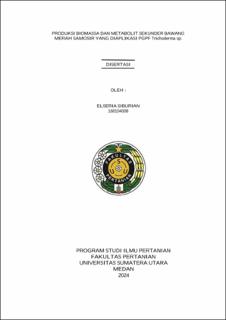Produksi Biomassa dan Metabolit Sekunder Bawang Merah Samosir yang Diaplikasi PGPF Trichoderma sp.
Production of Biomass and Secondary Metabolites of Samosir Shallots Applied with PGPF Trichoderma sp.

Date
2024Author
Siburian, Elseria
Advisor(s)
Siregar, Luthfi Aziz Mahmud
Lisnawita
Metadata
Show full item recordAbstract
Shallots are one of the leading national vegetable commodities which function as a food seasoning, used as industrial raw materials such as fried onions, flour, dry slices, wet slices, oleoresin, oil, pasta and pickles and as a source of biopharmaceuticals. The Samosir variety of red onions is always in demand by consumers because it has a distinctive aroma, brighter color, lower water content, has a spicier taste and lasts longer, but production of these red onions is still less than optimal. One of the causes is inappropriate cultivation techniques, such as the continuous use of chemical fertilizers, which results in land hardening, depletion of micro nutrients, groundwater pollution, and the development of certain pests and diseases, and ultimately has an impact on decreasing land productivity and Samosir shallot production. The use of organic, natural and biological fertilizers is an alternative method to overcome the problem of decreasing land quality and crop production as a result of intensive cultivation of shallots. The use of Trichoderma sp with superior capabilities can be used as a biostimulant for the growth of shallot plants
The aim of this research is to obtain the type and dose of Trichoderma sp. the best in increasing biomass production and secondary metabolite content which affects the taste and aroma of Samosir shallots. Determining the best location for planting shallots from selected isolates to increase biomass production and secondary metabolite content which affects the taste and aroma of Samosir shallots.
The first stage of research in Dolok Martumbur Village, Muara District, North Tapanuli Regency was carried out from June to December 2021 using a Factorial Randomized Block Design (RAK) with factor I being T1: Trichoderma harzianum, T2: Trichoderma virens, T3: Trichoderma viridee, T4: Trichoderma asperellum . Factor II is the dose of Trichoderma sp. (D) namely: D0: 0 g/polybag, D1: 20 g/polybag, D2: 40 g/polybag, D3: 60 g/polybag with 3 repetitions. The research results showed that the use of T. asperellum isolates was better and had given positive results at low doses (20 g/polybag). The T. asperellum isolate has the potential to increase the agronomic characteristics, production and total pyruvate of Samosir shallot plants compared to other isolates. Increasing the dose of isolate to 60 g/polybag also increased plant height, number of leaves, fresh root weight, number of tubers, tuber diameter and total pyruvate compared to the control. The interaction of T. asperellum isolates with a dose of 20 g/polybag has given a positive response to tuber weight and production/ha, but a dose of 40 g/polybag can also be used. Shallot production/ha is positively and significantly influenced by root wet weight, number of bulbs, bulb weight and total pyruvate.
The second stage of research was carried out in 3 villages in Muara District, North Tapanuli Regency, North Sumatra, Indonesia from February to August 2022. A factorial Randomized Block Design was selected with 3 replications. The first factor is the application of the selected isolate, namely T. asperellum (no application; application), while the second factor is the planting location (Sidimpula Village, Aritonang, Dolok Martumbur). Data were processed using ANOVA and continued with 5% DMRT. The results showed that there was an increase in plant height, root volume, root weight, and onion stover weight due to administration of T. asperellum isolates compared to the control. The planting location in Aritonang Village significantly influenced plant height, number of leaves, and root weight of shallots, while the highest stover weight was found in Dolok Martumbur Village. The interaction of selected Trichoderma with different planting locations had no significant effect on the growth of several shallot plants.
